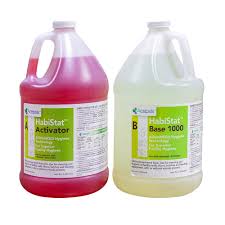Chlorine dioxide disinfectant

Chlorine dioxide is mainly used as a bleach. As a disinfectant it is effective even at low concentrations, because of its unique qualities. Chlorine dioxide is used to sterilise medical and laboratory equipment, surfaces, rooms and tools. Chlorine dioxide can be used as oxidizer or disinfectant. It is a very strong oxidizer and it effectively kills pathogenic microorganisms such as fungi, bacteria and viruses. It also prevents and removes biofilm.
What are the disinfection applications of chlorine dioxide?
Drinking water treatment is the main application of disinfection by chlorine dioxide. Thanks to its adequate biocidal abilities, chlorine dioxide is also used in other branches of industry today. Examples are sewage water disinfection, industrial process water treatment, cooling tower water disinfection, industrial air treatment, mussel control, foodstuffs production and treatment, industrial waste oxidation and gas sterilisation of medical equipment.
How does disinfection by chlorine dioxide work?
Substances of organic nature in bacterial cells react with chlorine dioxide, causing several cellular processes to be interrupted. Chlorine dioxide reacts directly with amino acids and the RNA in the cell. It is not clear whether chlorine dioxide attacks the cell structure or the acids inside the cell. The production of proteins is prevented. Chlorine dioxide affects the cell membrane by changing membrane proteins and fats and by prevention of inhalation.
When bacteria are eliminated, the cell wall is penetrated by chlorine dioxide. Viruses are eliminated in a different way; chlorine dioxide reacts with peptone, a water-soluble substance that originates from hydrolysis of proteins to amino acids. Chlorine dioxide kills viruses by prevention of protein formation. Chlorine dioxide is more effective against viruses than chlorine or ozone.
Can chlorine dioxide be used against protozoan parasites?
Chlorine dioxide is one of a number of disinfectants that are effective against Giardia Lamblia and Cryptosporidium parasites, which are found in drinking water and induce diseases called 'giardiasis' and 'cryptosporidiosis'. The best protection against protozoan parasites such as these is disinfection by a combination of ozone and chlorine dioxide.
Can microorganisms become resistant against chlorine dioxide?
Chlorine dioxide as a disinfectant has the advantage that it directly reacts with the cell wall of microorganisms. This reaction is not dependent on reaction time or concentration. In contrast to non-oxidizing disinfectants, chlorine dioxide kills microorganisms even when they are inactive. Therefore the chlorine dioxide concentration needed to effectively kill microorganisms is lower than non-oxidizing disinfectant concentrations. Microorganisms cannot built up any resistance against chlorine dioxide.
Chlorine dioxide as a disinfectant has the advantage that it directly reacts with the cell wall of microorganisms. This reaction is not dependent on reaction time or concentration. In contrast to non-oxidizing disinfectants, chlorine dioxide kills microorganisms even when they are inactive. Therefore the chlorine dioxide concentration needed to effectively kill microorganisms is lower than non-oxidizing disinfectant concentrations. Microorganisms cannot built up any resistance against chlorine dioxide.
Can chlorine dioxide be used against bio film?
Chlorine dioxide remains gaseous in solution. The chlorine dioxide molecule is powerful and has the ability to go through the entire system. Chlorine dioxide can penetrate the slime layers of bacteria, because chlorine dioxide easily dissolves, even in hydrocarbons and emulsions. Chlorine dioxide oxidizes the polysaccharide matrix that keeps the bio film together. During this reaction chlorine dioxide is reduced to chlorite ions. These are divided up into pieces of bio film that remain steady. When the bio film starts to grow again, an acid environment is formed and the chlorite ions are transformed into chlorine dioxide. This chlorine dioxide removes the remaining bio film.


 Available 6 Days
Available 6 Days